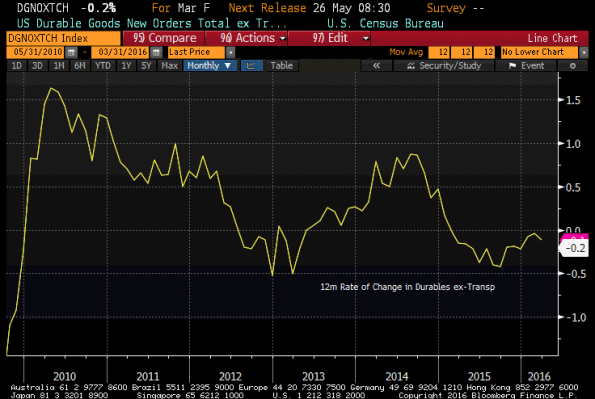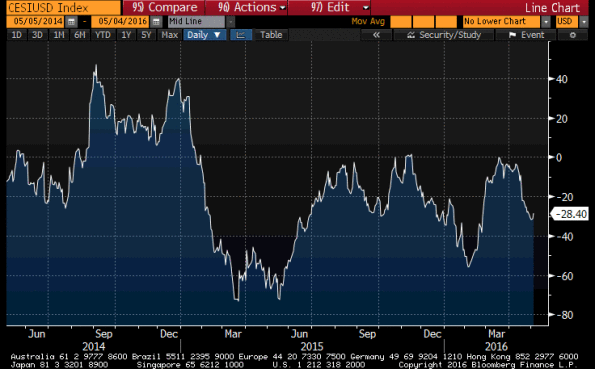Durable goods orders, ex-transportation, showed a negative print yesterday for the second time in a row. This was expected, in most senses of the word, but while I don’t put too much weight on short-term wiggles in Durables it is hard to ignore the fact that the year/year change in Durables has now been negative for more than a year (see chart, source Bloomberg).
So the weakness in Durables is not new. But it bears noting that the last time core Durables went negative, in August 2012, the Fed followed with QE3 almost immediately. To be sure, at the time core inflation was all the way down at 1.9%, whereas today it is a heady 2.2%…
Look, any Fed watcher right now is and should be confused. Conditions which provoked QE just four years ago are now apparently spurring a tightening bias. Bill Gross can be excused for thinking that the Fed will go back to the old playbook and employ new QE, as he apparently did in his latest Investment Outlook – it is harder to excuse his saying that the Fed should drop money, given that it hasn’t worked yet.
But clearly, something is different in the way the central bank is approaching monetary policy. After all, nothing about this weakness is new. As noted, Durables have been negative on a year-over-year basis for a full year, and the Citi Economic Surprise index shows that economists have managed to be surprised on the negative side for an unprecedented fifteen months in a row (see chart, source Bloomberg).
Okay, the index technically turned positive once or twice for a day or two, but this is still the longest run of persistently optimistic errors that economists have had in a very long time. So this isn’t new – the economy is weak.
Unless…unless what is different is that in 2012, economists were pessimistic (the Citi Economic Surprise index turned positive right before the Fed started QE, which means that either the data was too strong or economists were too negative) whereas today they are more generally optimistic? It would be entirely consistent with how the Fed has been run for the last couple of decades if monetary policy was not being guided by actual data, but by forecasts of data. (See my book for more on monetary policy errors!)
Evidence is pretty clear that recently economists as a whole have not only been wrong, but wrong in a biased way, which is much worse. If you are merely a bad shot, you miss the target in all kinds of directions. But if you persistently miss the target in one direction, then it may well be that your weapon sights are not properly calibrated. The first sort of unbiased miss is not as dangerous, even if too much confidence is placed on the shot, because the errors will even out over time. You might eventually hit the target, by accident. But if the target sights are biased, then you will never hit the target until you realize you’re wrong. You would be tightening when you should be easing. A broken clock is right twice per day, but only if it is stopped and not just systematically two hours off.
Now, regular readers of these columns will understand that I don’t think the Fed should be easing. I don’t think the Fed can fix what ails growth, since monetary policy only affects the price variable, and easy money has only created the conditions for the inflationary upswing we are currently experiencing (Gross also acknowledges this, but sees the inflationary upswing somewhere in the unthreatening future while in fact it is here now). The Fed should have eschewed QE2 and QE3, and have long since begun to drain excess reserves. But what I think the Fed should do and forecasting what I think they will do are two very different things.
I suspect Gross is close to right. Absent some recovery in the real economy – something other than payrolls, which as we know lag – it strikes me as unlikely the Fed will be hiking rates again. Ironically, that may help keep inflation leashed for longer since it will help keep monetary velocity constrained – but I am not confident of that, given how low interest rates already are. Since inflation is very unlikely to wane any time soon, I think we are more likely to see the yield curve steepen from these levels, rather than flatten. A yield curve inversion is not a prerequisite for recession. Inverted yield curves tend to precede recessions only because the Fed is typically slow to lower interest rates in response to obvious weakness. In this case, rates are already low and the Fed isn’t likely to raise them and force a curve inversion. Yield curve inversions are not causal! This next recession may catch some people wrong-footed because they keep waiting for the inversion that never comes.
In my next article, I am going to revisit an issue I first addressed a couple of years ago and which might be especially relevant as recession possibilities increase: the question of how we can have both deflation and inflation, and how these concepts are often confused by those people who are stuck in the nominal world.
Editor's Note: Michael Ashton’s new book What’s Wrong With Money? The Biggest Bubble of All has been published by Wiley and is available from booksellers in hardback and e-book formats. You can also find it here. The book concerns the functions and weaknesses of money, the likely trajectory for inflation, and how investors can invest in an ‘inflation-aware’ way.


